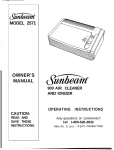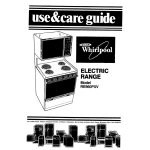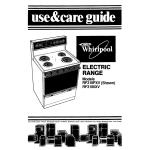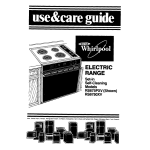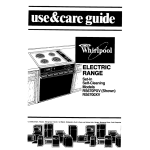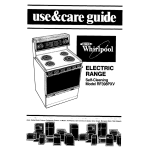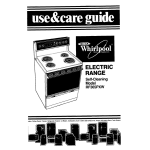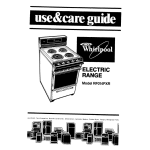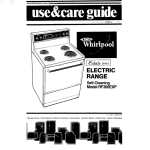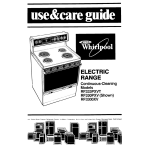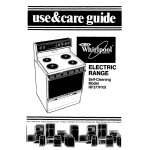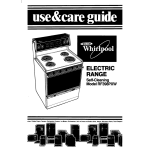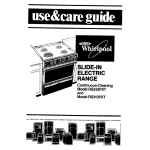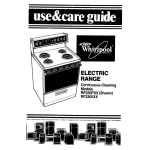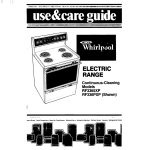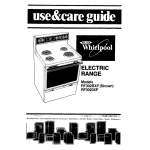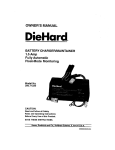Download Whirlpool RE960PXV User's Manual
Transcript
ELECTRIC RANGE Models RE963PXV RE960PXV (Shown) Contents Page BEFORE YOU USE YOUR RANGE. IMPORTANT SAFETY INSTRUCTIONS, PARTS AND FEATURES USING YOUR RANGE. Using the Surface Units Optional Canning Kit Setting the Clock Using the Minute Timer Using the Oven Controls Baking Broiling Using the Automatic MEALTIMER’ Clock Oven Vent Storage Drawer Optional Rotisserie Optional Door Panel Pat 2 3 4 5 5 6 7 7 8 8 10 11 12 13 14 14 CARING FOR YOUR RANGE Control Panel and Knobs Surface Units and Reflector Bowls Lift-Up Cooktop Upper Oven Rack Guides Continuous-Cleaning Upper Oven Using the Self-Cleaning Cycle Cleaning Chart Using and Replacing the Light Bulbs Cooktop Light Oven Lights IF YOU NEED SERVICE OR ASSISTANCE WHIRLPOOL RANGE WARRANTY Page 14 14 15 17 17 18 20 22 24 24 25 26 28 L 01988 Whirlpool ‘Tmk. Corporation Before you use your range Read this Use 81Care Guide safety information. and the Cooking Guide for important You are personally responsible for: Reading and following all safety precautions in this Use & Care Guide and the Cooking Guide. l Installing the range where it is protected from the elements, and on a floor strong enough to support its weight. l Properly connecting the range to electrical supply and grounding. (See Installation Instructions.) l Making sure the range is not used by anyone unable to operate it properly. l Properly maintaining the range. l Using the range only for jobs expected of a home range. l See Cooking Guide for important safety and use information. IMPORTANT SAFETY INSTRUCTIONS 1. DO NOT allow children to use or play with any part of the range, or leave them unattended neclr it They could be burned or injured 2. DO NOT store things children might want above the range. Children could be burned or injured while climbing on it. 3. DO NOT allow anyone to touch hot surface units or heating elements. Dark colored units and elements can still be hot enough to burn severely. 4. KEEP children away from the range when it is on. The cooktop and oven walls, racks and door can get hot enough to cause burns. 5. DO NOT use the range to heat a room. Persons in the room could be burned or injured, or a fire could start 6. KEEP pan handles turned in. but not over another silrface unit to avoid burns, injury 0% to help prevent the utensil r:or;i be/rig pushed off the surfacs til?its 7. DO NOT use water orl grease fires. The fire will spread. Cover fire with large lid or smother with baking soda or salt 8. DO NOT wear loose or han(.!ing garments when using the range They could ignite if they touch a hot surface unit or heating eiement and you could be burned 9. DO NOT heat unopened containers. They could explode. The hot contents could burn and container particles could cause injury. 10. When adding or removing food, the oven door all the way to prevent burns. MAKE SURE to open l FOR YOUR SAFETY. DO NOT STORE OR USE GASOLINE OR OTHER FLAMMABLE VAPORS AND LIQUIDS IN THE VICINITY OF THIS OR ANY OTHER APPLIANCE. THEY COULD IGNITE CAUSING EXPLOSION AND/OR FIRE. - SAW THESE INSTRUCTIONS - Thank you for buying a Whirlpool appliance. Please complete and mail the Owner Registration Card provided with this product. Then complete the form below. Have this information ready if you need service or call with a question. l l Copy model and serial numbers from plate (behind the oven door on the oven frame) and purchase date from sales slip. Model Number Serial Number Keep this book and sales slip together in the Literature Pac. Purchase Service Date Company Phone Number Parts and features Models RE963PXV and RE960PXV CONTINUOUSCLEANING OVEN \ GWKIWP LIGHT, \ PORCELAIN-ENAMEL EFLECTOR BOWL AND CHROME TRIM RING MODEL AND SERIAL NUMBER PLATE SELF-CLEANING BROIL ELEMENT VEN RACK GUIDE BAKE ELEMENT REMOVABLE STORAGE DRAWER LITERATURE PAC (not shown) I CLOCK AND MINUTE TIMER CONTROL KNOB / MINUTE TIMER START TIME KNOB - 1 - DIGITAL CLOCK STOP TIME KNOB -UPPER OVEN “HEATING” SIGNAL LIGHT I UPPER OVEN SELECTOR LOWER OVEN “HEATING” SIGNAL LIGHT UPPER OVEN -TEMPERATURE CONTROL LOWER OVEN TEMPERATURE CONTROL LOWER OVEN SELECTOR A SELF-CLEAN 4 “LOCKED” SIGNAL LIGHT LEFI REAR CONTROL KNOB SURFACE UNIT SIGNAL LIGHTS -CONTROL RIGHT REAR KNOB TOP LIGHT SWITCH /ONTROL /VEN RIGHT FRONT PANEL LIGHT SWITCH LEFT FRONT CONTROL KNOB Using your range Using the Surface Units Signal light One of the signal lights will glow when a surface unit is on. Surface unit control knobs must be pushed in before turning. Turn either way until setting you want shows in the window. Set them anywhere between HI and LOW. Until you get used to the settings, use the following as a guide. For best results, Start cooking at the high settings; then turn the control knob down to continue cooking. Use MED-HI to hold a rapid boil; to fry chicken or pancakes. Use HI to start foods cooking; to bring liquids to a boil. Use MED for gravy, puddings and icing; to cook large amounts of vegetables. Use MED-LO to keep food cooking after starting it on a higher setting. CAUTION: The use of the HI setting for long periods of time can damage surface units and discolor chrome trim rings. Start cooking on HI and turn control down to continue cooking. Use LO to keep food warm until ready to serve. Set the heat higher or lower within the LO band to keep food at the temperature you want. Use only flat-bottomed utensils for best cooking results and to prevent damage to the cooktop. Specialty items with rounded or ridged bottoms [woks, ridged bottom canners or tea kettles] are not recommended. See the Cooking Optional Guide for important utensil Canning Kit (Part NO. information. 242905) The large diameter of most water-bath or pressure canners combined with high heat settings for long periods of time can shorten the life of regular surface units and cause damage to the cooktop. If you plan to use the cooktop for canning, we recommend the installation of a Canning Kit. Order the kit from your Whirlpool Dealer or Tech-Care” Service Company. See the Cooking 6 Guide for important canning information. Setting the Clock Push in and turn the Minute Timer Knob to set the Clock. 1. Push in Minute Timer Knob and turn clockwise until clock shows the right time of day. 2. let the Minute Timer Knob pop out. Turn counterclockwise until the Minute Timer dial is on OFF. The clock setting will change if you push in the knob when turning. Using the Minute Timer The Minute Timer does not start or stop the oven. It works like a kitchen timer. Set it in minutes up to an hour. You will hear a buzzer when the set time is up. DO NOT PUSH IN THE KNOB when setting the Minute Timer. 1. Without pushing it in, turn the Minute Timer Knob until the time in the window passes the setting you want. PUSHING SETTING. 2. Without pushing in, turn the knob back to the setting you want. When the time is up, a buzzer will sound. To stop the buzzer, turn the Minute Timer dial to OFF IN AND TURNING THE MINUTE TIMER KNOB CHANGES THE CLOCK Using the Oven Controls Baking in Either Oven The rack(s) should be placed so the top of the food will be centered in the oven. Always leave at least lY2 to 2 inches (4-5 cm) between the sides of the pan and the oven walls and other pans. For more information, see the Cooking Guide. 1. Position the rack(s) properly before turning on the oven. To change rack position, lift rack a: front and pull out. 2. Set the Oven Selector to BAKE. 2 3. Set the Oven Temperature Control to the baking temperature you want. The “heating” Signal Light will come on. The oven is preheated when the “heating” Signal Light first goes off. 4. Put food in the oven. NOTE: Oven racks, walls and door will be hot. During baking, the elements will turn on and off to keep the oven temperature at the setting. The “heating” Signal Light will turn on and off with the elements. 8 The top element helps heat during baking, but does not turn red. 5. When baking is done, turn both the Oven Selectcr and Oven Temperature Control to OFF. Adjusting the Oven Temperature Controls Does your oven seem hotter or colder than your old oven? The temperature of your old oven may have shifted gradually without you noticing the change. Your new oven is properly adjusted to provide accurate temperatures. But, when compared to your old oven, the new design may give you different results. If after using the oven for a period of time, you are not satisfied with the temperature settings, they can be adjusted by foll%Gng these steps: LOCKING SCREW 1. Pull the Oven Temperature Knob straight off. Control 2. Loosen the locking screw insrde the control knob. Note the position of the notches. NOTCHES 3. To lower the temperature, move the tooth a notch closer to LO. Each notch equals about 10°F (5°C). TOOTH 4. To raise the temperature, move the tooth a notch closer to HI. Each notch equals about 10°F (5°C). Tighten replace the locking the control screw and knob. 9 Broiling 1. in Either Oven Position the rack before turning the oven on. See “Broil Chart’ in the Cooking Guide or a reliable cookbook for recommended rack positions. 3. Close the door to the Broil Stop position (open about 4 inches, 10.2 cm). The door will stay open by itself. 2. Put the broiler the rack. pan and food on 4. Set the Oven Selector and Oven Temperature Control to BROIL. The “heating” Signal Light will come on. 5. When broiling is done, turn both the Oven Selector and Oven Temperature Control to OFF. The “heating” Signal Light will go off. Custom l l Broil If food is cooking too fast, turn the Oven Temperature wise until the “heating” Signal Light goes off. Control counterclock- If you want the food to broil slower from the start, set the Oven Temperature Control between 150” and 325°F (65.5” and 162.7”C). The lower the temperature, the slower the cooking. The Oven Selector must be on BROIL for all broiling NOTE: The door must be partly leaving the door open allows 10 temperatures. open whenever the oven is set to BROIL. the oven to maintain proper temperatures. Using the Automatic MEALTIMER” Clock The automatic MEALTIMER’ Clock is designed to turn the oven on and off at times you set, even when you are not around. Automatic baking is ideal for foods which do not require a preheated oven, such as meats and casseroles. Do not use the automatic cycle for cakes, cookies, etc...undercooking will result. ‘Tmk. To start and stop baking 1. automatically: Position the oven rack(s) property and place the food in the oven. 3. Push in and turn the Star-l Time Knob clockwise to the time you want bakina to start . Set the Oven Selector on TIMED. 2. Make sure the clock is set to the right time of day. 4. Push in and turn the Stop Time Knob clockwise to the time you want the oven to shut off. 6. Set the Oven Temperature Control on the baking temperature you want. The oven will now start and stop automatically. After baking is done or to stop the oven before preset time, turn both the Oven Selector and the Oven Temperature Control to OFF 11 To start baking 1. now and stop automatically: Position rack(s) properly 2. Make sure the clock and place the food in the oven. is set to the right time of day. 3. Push in and turn the Stop Time Knob clockwise to shut off. 4. Set the Oven Selector on TIMED. 5. Set the Oven Temperature 6. to the time you want the oven Control on the baking temperature you want. After baking is done or to stop the oven before the preset time, turn both the Oven Selector and the Oven Temperature Control to OFF The Oven Vent Hot air and moisture escape from the oven through a vent under the right rear surface unit. You can cook on the unit, or keep food warm on it while the oven is on. CAUTION: Plastic utensils over the vent can melt. left Do not block can result. 12 the vent. Poor baking The Storage Drawer The storage drawer is for storing pots and pans. Use care when handling the drawer. Removing 1. 1. drawer Pull drawer straight out to the first stop. Lift front and pull out to the second stop. Replacing I the storage the storage 2. Lift back slightly andzde all the way out. drawer drawer SLIDE RAIL yy Fit ends of drawer slide rails into the drawer guides on both sides of opening. I 2. Lift drawer front and push in until metal stops on drawer slide rails clear white stops on drawer guides. Lift drawer front again to clear second stop and slide drawer closed. Use & Care Guide storage Store this booklet, along with your Cooking Guide and sales slip in the Literature Pat, inside the storage drawer. I Optional Rotisserie If you would like a rotisserie for your lower oven, you can order a kit (Part No. RCK-81/242985) from your Whirlpool Dealer. The kit includes easy installation instructions. Optional Door Panel Pat If you would like to change the color of your oven door glass to white or almond, you can order one of these kits; White (Kit No. 814069) or Almond (Kit No. 814070) from your Whirlpool Dealer. The kits include easy installation instructions. Caring for your range Control Panel and Knobs 1. 2. Pull knobs straight off. NOTE: Surface unit control knobs have a collar and a spring behind them. Use warm soapy water or spray glass cleaner and a sott cloth to wipe the control panel. Rinse and dry well. 1 I I 3. Wash control knobs and surface unit collars in warm soapy water. Rinse and dry well. 14 I CONTROL PANEL. 4. Push control knobs straight back on. Make sure they point to OFF. Make sure the collar and spring behind the surface unit control knobs are put together as shown. Surface Units and Reflector Bowls Removing 2. Lift the edge of the unit opposite the receptacle, just enough to clear the element hold down clip, reflector bowl and trim ring. 3. Pull the surface unit straight away from the receptacle. 4. Lift out the reflector bowl and trim ring. See “Cleaning Chart” on page 23 for cleaning instructions. Replacing I I 2. Line bowl with and up openings in the reflector and notch in the trim ring the surface unit receptacle the element hold down clip. 15 I. 3. Hold the surface unit as level as possible with the terminal just started into the receptacle. Push the surface unit terminal into the receptacle. CAUTION: Reflector bowls reflect heat back to the utensils on the surface units. They also help catch spills. When they are kept clean, they reflect heat better and look new longer. If a trim rfng gets discolored, some of the utensils may not be flat enough, or some may be too large for the surface unit. In either case, some of the heat that’s meant to go into or around a utensil goes down and heats the trim ring. This extra heat can discolor it. See Cooklng Gufde for further informatlon. 16 J 4. When terminal is pushed into the receptacle as far as it will go, push down the edge of the surface unit opposite the receptacle. The element hold down clip will keep the surface unit from moving around. Lift-Up Cooktop 1. Lift front of cooktop at both front corners until the support rods lock into place. 2. Wipe with warm soapy water. Use a soapy steel wool pad on stubborn spots. CAUTION: Do not drop the cooktop. Damage can resuif to the porcelain and the cooktop frame. 3. To lower the cooktop, lift cooktop from both sides while pressing the support rods back to unlock them. Lower the cooktop into place. The Upper Oven Rack Guides Removing the upper upper oven. oven rack guides Lift the front of the rack guides. will help make itI easier to clean the 2. Swing the front of the rack guides away from the oven wall far enough so the tab in the guides clears the notch in the oven wall. Pull the guides straight away from the back wall. REVERSETHE PROCEDURE TO REPLACE RACK GUIDES. The Continuous-Cleaning Upper Oven Standard oven walls are coated with smooth porcelain, Your ContinuousCleaning oven walls are coated with a special, rougher porcelain. A fat spatter beads up on the smooth surface, but spreads out on the rougher surface. The bead of fat on the smooth surface chars and turns black. The spread-out fat on the rough surface gradually burns away at medium to high baking temperatures so the oven can return to a presentably clean condition. Using Foil Using foil on the oven bottom is recommended to catch sugar and starchy spills from pies and casseroles. It must be used properly. Cut foil from a roll of heavy-duty18-inch (45 cm] aluminum foil, or buy a foil kit (Part No. 241430) from your Whirlpool Appliance dealer. 1. 2. Lift the cool bake element slightly to litl the feet off the oven bottom. Slide the foil under the bake element. Make sure the foil is centered, long enough to start up both sides and without wrinkles. For proper baking, lower the bake element so all feet rest solidly on the foil. CAUTION: DO not let foil touch the bake element. It could damage the element. Make sure toll Is flat on the oven bottom and away from the bake element. Cleaning 1. Tips The oven window and racks are not coated. Clean them by hand. 2. The oven door does not get as hot as the walls. Some hand Cleaning needed. 3. If you do more broiling 4. 18 than baking, hand cleaning Use aluminum foil on the oven bottom according may not burn away and could stain the bottom. may be may be needed. to instructions, Spill-overs Hand Cleaning WINDOW - Keep clean with hot soapy water. Use a plastic scrubbing pad for stubborn spots. Rinse well. Do not use steel wool or abrasive cleansers. !ACKS - Use a soapy bad for best cleaning ielI. steel wool results. Rinse WALLS AND DOOR-Wash with hot soapy water. Use a steel wool pad or plastic scrubbing pad for stubborn spots. Rinse well. Using the Self-Cleaning Cycle The Self-Cleaning cycle uses very high heat to burn away soil. Before you start, make sure you understand exactly how to use the Self-Cleaning cycle safely. Before You Start 1. Clean the shaded areas by hand. They do not get hot enough during the Self-Cleaning cycle for soil to burn away. Use hot water and detergent or a soapy steel wool pad on... l The inside of the door. l The frame around the oven. 00 NOT clean the fiberglass seal. 00 NOT move it or bend it. Poor cleaning and poor baking will result. 2. Remove the broiler pan and any pots and pans you may have stored in the oven. They can’t stand the heat. 3. Wipe out any loose soil or grease. This will help reduce smoke during the Self-Cleaning cycle. 4. If the oven has a rotisserie, make sure the motor socket cover is closed. 5. if you want the oven racks to remain shiny, remove from the oven and clean by hand. Ctherwise, put oven racks on second and fourth guides (guides are counted from bottom to top). After racks are cleaned in the SelfCleaning cycle, they become harder to slide. See chart on page 23. 6. if you want to clean the reflector bowls in the oven: l Wipe the reflector bowls of loose soil and grease. l Place 2 bowls, upside down on each oven rack. For best results, they should not touch each other or the oven walls. l Chrome trim rings must not be cleaned in the oven. They will discolor. Turn on the vent hood or other kitchen vent during the Self-Cleaning cycle. This will help remove heat and odors that are normal during the cycle. SPECIAL CAUTIONS: 00 NOT use commercial oven cleaners in your oven. Damage the porcelain ffnish may occur. to 00 NOT force the lock lever, you could bend or break it. The lever is designed to stay locked until the oven is cool enough to safely open. Wait until it moves freely. 00 NOT use foil or other liners in the oven. During the Self-Cleaning cycle foil can burn or melt and damage the oven surface. 20 00 NOT block the vent during the Self-Cleaning cycle. Air must move freely for best cleaning results. Setting the Co Be sure the kitchen normal smoke and 1. Set the Oven Selector and the Oven Temperature Control on CLEAN. 2. Make sure the Clock, Start and Stop Times all have the right time of day. 3. Push in and turn the Stop Time Knob clockwise 2 or 3 hours. l Use 2 hours for light soil. l Use 3 hours or more for moderate to heavy soil. 4. Move the Lock Lever to the right - 5. The “locked” Signal Light comes an when the oven iemperature exceeds normal baking temperalures. The Lock Lever must not be rnoved and the door can’t be opened when the Xcked” Signal Light is on. 6. the Clean position. The “heating” Signal Light will come on. After the Self-Cleaning cycle is completed, the “locked” Signal Light goes off. Move the Lock lever back to the left. 00 not force it. Wait until it moves easily Turn the Oven Selector and Oven Temperature Control to OFF 7. After the oven is cool, wipe off any residue or ash with a damp cloth. If needed, touch up spots with a soapy steel wool pad. 21 Special Tips Keep the kitchen well ventilated during the Self-Cleaning cycle to help get rid of normal heat, odors and smoke. Clean the oven before it gets heavily soiled. Cleaning a very soiled oven takes longer and results in more smoke than usual. If the Self-Cleaning cycle doesn’t get the oven as clean as you expected, the cycle may not have been set long enough or you may not have prepared the oven properly. Set the Self-Cleaning cycle longer the next time and hand clean areas noted on page 20. l l l To stop the Self-Cleaning at anytime: 1. cycle Push in and turn the Stop Time Knob clockwise until it points to the right time of day, 2. Turn the Oven Selector and Oven Temperature Control to OFF. When the Lock Light goes off, move the Lock Lever back to the left. DO NOT FORCE IT. Wait until it moves easily. How It Works During the Self-Cleaning cycle, the oven gets much hotter than it does for baking or broiling...approximately 875°F (468°C). This heat breaks up grease and soil and burns it off. This graph shows approximate temperatures and times during a SelfCleaning cycle for 3 hours. SELF-CLEANING CYCLE-THREE [Approximate Temperatures HOUR SEITING and limes) 1000°F 538°C 800°F 427°C 600°F 316°C 400°F 204°C 200°F 93°C START K hr. 1 hr. 1h hrs. 2 hrs 2 V’I hrs. 3 hrs. 3 Y hrs. STOP Notice that the heating stops when the 3-hour setting is up, but that it takes longer for the oven to cool down enough to unlock. Cleaning Chart PART WHAT TO USE Exterior surfaces Warm soapy water a soft cloth. Plastic scrubbing for stubborn HOW TO CLEAN and l when oven is cool. pad l spots. l 22 Wipe off regularly Do not allow food containing acids (such as vinegar, tomato, lemon juice or milk) to remain on surface. Acids will remove the glossy finish. Do not use abrasive or harsh cleansers. PART HOW TO CLEAN WHAT TO USE Surface units No cleaning required. l l Porcelainenamel reflector bowls Warm soapy water and a plastic scrubbing pad. Self-Cleaning cycle. Chrome trim rings Warm soapy water a plastic scrubbing and pad. Control Warm soapy a soff cloth. and Control knobs panel Broiler pan and grid water l l l Wash, rinse ond dry well. Clean frequently. 8 Do not use abrasive or harsh cleansers. l Do not clean in Self-Cleaning Oven. l l l l Warm soapy water or a soapy steel wool pad. l l l Oven racks Oven door glass Wash, rinse and dry well. Follow directions provided the cleaner. Clean after each use. Wash, rinse and dry well. Do not clean in Self-Cleanina with Oven. Leave in oven during Self-Cleaning Self-Cleaning cycle. cycle. OR l Wash, rinse ond dry. Use soapy steel Warm soapy water or wool pads for stubborn areas. soapy steel wool pads. NOTE: The oven racks will discolor and be harder to slide when left in the Self-Cleaning cycle. If you want them to stay shiny, remove from the oven and clean by hand. Spray glass cleaner or warm soapy water and a plastic scrubbing pad. l l Warm soapy water or a soapy steel wool pad. l l Heavy-duty or shallow aluminum pan. foil l l Self-Cleaning Oven Wash, rinse and dry well. Do not soak. l l ContinuousCleaning Oven Wipe off excess spills. Wash, rinse and dry well. Place upside down on oven racks in oven during the Self-Cleaning cycle. l l Warm soapy water or spray glass cleaner and a soft cloth. Spatters or spills will burn off Do not immerse in water. For areas outside the Self-Cleaning area use warm soapy water or soapy steel wool pads. l l l Make sure oven is cool. Follow directions provided the cleaner. Wash, rinse and drv well. with Most fat spatters on oven walls and floor will gradually reduce to a presentably clean condition during baking. Clean stubborn spots or stains, Rinse well with water. Place piece of foil on shallow pan, slightly largerthan the cooking container, on lower rack to catch spill-overs. Do not use commercial oven cleaners. Follow directions starting on page 20, “Using the Self-Cleaning Cycle:’ Do not use commercial oven cleaners. Do not use foil to line the bottom of your Self-Cleaning Oven. 23 Using and Replacing the Light Bulbs The Cooktop light The fluorescent top light is under the control panel. The Top Light Switch is on the control panel. Push it in and hold it for a few seconds to turn on the top light. Push it again to turn it off To Replace: 2. With both hands, pull top of light cover towards you and lift it out of bottom support trim. Remove the 3 screws and metal trim that supports the top of the light cover. The glass is heavy. Hold it securely. 3. Grasp the fluorescent tube at both ends. Roll the tube away from you until both ends come out of the receptacles. Replace with a 20watt cool-white fluorescent tube. 24 4. With both hands, carefully fit the glass light cover into the bottom metal support trim. Then rotate the top of the light cover until it touches the contact stops. Replace the top support trim and 3 screws. Turn electric power back on at the main power supply. The Oven lights Both the oven lights will come on when you open the lower oven door. To turn both lights on when the lower oven door is closed, push the Oven Light Switch on the control panel. Push it again to turn off the light. To Replace the Upper Oven light: 2. Remove the light bulb from its socket. Replace with a 40-watt appliance bulb. Turn the power back on at the main power supply. To Replace the lower Oven Liaht: 2. Remove the bulb cover in the back of the oven by pulling out and pushing the wire holder to the side. 3. Remove the light bulb from its socket. Replace the bulb with a 40-watt appliance bulb. I CAUTION: The cover 4. Replace the bulb cover and snap the wire holder in place. Turn the power back on at the main power supply. The bulb cover must be in place protects the bulb from breaking. NOTE: The oven light will not work during when using the oven. 1 the Self-Cleaning cycle. 25 If you need service or assistance, we suggest you follow these five steps: 1. Before calling for assistance... Performance problems often result from little things you can find and fix without tools of any kind. If nothing operates: Is the power supply cord plugged into a live circuit with the propervoltage? (See Installation Instructions.) l Have you checked your home’s main fuses or circuit breaker box? If the oven will not operate: l Is the Oven Selector turned to a setting (BAKE or BROIL, but not TIMED)? l Is the Oven Temperature Control turned to a temperature setting? l If surface units will not operate: Have you checked your home’s main fuses or circuit breaker box? l Are surface units plugged in all the way? l Do the control knobs turn? l If surface unit control knob(s) will not turn: l Did you push in before trying to turn? If soil is visible on ContinuousCleaning oven finish: l The special finish is designed to gradually reduce oven soil during normal baking or roasting. It is not designed to keep your oven spotless, only presentably clean. l If you broil often, you may see oven soil. l The door is cooler than the oven walls. Soil will be more visible on the door than other areas in the oven. See page19 for how to clean. l Sugar and starchy spills may leave stains. See page 19 for hand cleaning tips. Keep foil on oven bottom to catch these spills. 26 If the Self-Cleaning Cycle Will not operate: l Are the Oven Selector and Oven Temperature Control set on CLEAN? l Does the Start Time Dial show the correct time of day? l Is the Stop Time Dial set ahead to the time you want the cleaning cycle to stop? l Is the Lock Lever all the way to the right? If cooking results aren’t what you expected: l Is the range level? l Are you using pans recommended in the Cooking Guide? l If baking, have you allowed IYz to 2 inches (4-5 cm] on all sides of the pans for air circulation? l Have you preheated the oven as the recipe calls for? l Are the pans the size called for in the recipe? l Are you following a tested recipe from a reliable source? l Do the cooking utensils have smooth, flat bottoms and fit the surface unit being used? See the Cooking Guide for more information on cooking problems and how to solve them. 2. If you need assistance?.. Call Whirlpool COOL-LINER service assistance telephone number. Dial free from anywhere in the U.S.: 1-800-253-1301 and talk with one of our trained consultants The consuItan?s can instruct you in how to obtain satisfactory operation from your appliance or, if service is necessary, recommend a qualified service company in your area. 3. If you need service*... Whirlpool has nationwide a network of franchised TECH1 CARE” Service I Companies. &&E TECH-CARE servLFFI)ERVICEm I ice technicians are trained to fulfill the product warranty and provide after-warranty service, anywhere in the United States. To locate TECH-CARE service in your area, call our COOL-LINE service assistance telephone number (see Step 2) or look in your telephone directory Yellow Pages under: 4. If you have a problem? . . Call ourCOOL-LINE service assistance telephone number (see Step 2) and talk with one of our consultants, or if you prefer, write to: Mr. Donald Skinner Director of Customer Relations Whirlpool Corporation 2000 M-63 Benton Harbor, Ml 49022 5. If you need FSP’” replacement parts?.. FSP is a registered trademark of Whirlpool Corporation for quality parts. Look for this symbol of quality whenever you need a replacement part for your Whirlpool appliance. FSP replacement parts will fit right and work right, because they are made to the same exacting specifications used to build every new Whirlpool appliance. To locate FSP replacement parts in your area, referto Step 3aboveorcalI the Whirlpool COOL-LINE service assistance number in Step 2, *If you must call or write, please provide: model number, serial number, date of purcnase, and a complete description of the problem. This information is needed in order to better respond to your request for assistance. 27 WHIRLPOOL” RANGE PRODUCT W-TY EROOl LENGTH OF WARRANTY WHIRLPOOL FULL ONE-YEAR WARRANTY From Date of Purchase FSP” replacement parts and repair labor to correct defects in materials or workmanship. Service must be provided by a franchised TECH-CARE” service company. WHIRLPOOL WILL PAY FOR WILL NOT PAY FOR A. Service calls to: 1. Correct the installation of the range product. 2. Instruct you how to use the range product. 3. Replace house fuses or correct house wiring or plumbing. 4. Replace owner accessible light bulbs. 6. Repairs when range product is used in other than normal, single-family household use. C. Pick up and delivery. This product is designed to be repaired in the home. D. Damage to range product caused by accident, misuse, fire, flood, acts of God or use of products not approved by Whirlpool. WHIRLPOOL CORPORATION SHALL NOT BE LIAELE FOR INCIDENTAL OR CONSEQUENTIAL DAMAGES. Some states do not allow the exclusion or limitation of incidental or consequential damages so this limitation or exclusion may not apply to you. This warranty gives you specific legal rights, and you may also have other rights which vary from state to state. Outside the United States, a different warranty may apply. For details, please contact your franchised Whirlpool distributor or military exchange. Part No. 3148546 01988 Whirlpool Corporation e Makers. Dishwashers Bu~ll In Ovens and Surlace Un~ls. Ranges. Microwave Printed in U.S.A. Ovens Trash Compaclors Room AII Condllloners Dehumldlllen Aulomallc Wz




























